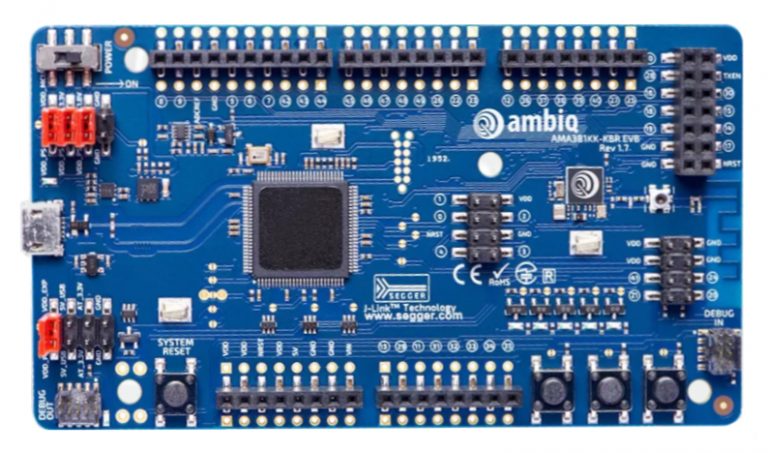Ambiq’s Apollo3 Blue SoC combines an ultra-low-power microcontroller and Bluetooth 5 LE functionality to create an ideal basis for long-life battery-powered devices. This is achievable through Ambiq’s patented Subthreshold Power Optimized Technology (SPOT®), which enables an ultra-low supply current of <6 μA/MHz (executing from flash or RAM at 3.3 V) and 1 μA current consumption in deep sleep mode (Bluetooth LE off) with RTC at 3.3 V.
A high-performance Arm Cortex-M4 processor is at the heart of Apollo3 Blue, with up to 96 MHz clock frequency (48 MHz nominal) to serve the device’s use as an applications processor for one or more sensors in your end product. This can be done via the many standard peripheral interfaces available within this device, but there is also a 14-bit ADC with 15 selectable input channels and up to 2.67 MS/s sampling rate, all optimised for ultra-low-power operation for extended battery life.
This processor includes a Floating Point Unit (FPU), a Memory Protection Unit (MPU), a wake-up interrupt controller with 32 interrupts, and is supported by up to 1 MB of low-power flash memory, up to 384 kB of low-power RAM, and a 16 kB 2-way associative/direct-mapped cache. A dedicated second core serves the ultra-low-power Bluetooth 5 LE functions to ensure ample processing power is reserved for the main peripherals in your application.
Target applications of the Apollo3 Blue include smart home devices, Bluetooth headsets, earbuds, remote and gaming controls, and other battery-powered wireless devices. Implementation of always-on voice-command features are supported by Apollo3 Blue’s PDM interface for mono and stereo audio microphones and I2S slave for PDM audio pass-through.
The Apollo3 Blue is also well suited for hearing aids, digital health monitors, security devices, and lighting control applications. Thanks to an innovative advanced stepper motor control, it can even be used for ultra-low power analogue watch hand management in smart watches.
Ambiq’s Apollo3 Blue can be powered using a 1.8-3.6 V supply, has an operating temperature from -40°C to 85°C, and is available in a 5 x 5 mm, 81-pin BGA package with 50 GPIOs, or a 3.25 x 3.37 mm, 66-pin WLCSP package with 37 GPIOs. A complete suite of standard software development tools is available to those aiming to integrate this device as part of their design.
While there is certainly an evaluation board, detailed specifications are only available through registration with Ambiq, so if you’ve got a commercial application where you want to evaluate the Apollo3 Blue, fill out the form below, and ipXchange will put you in touch with Ambiq.
For additional LoRaWAN capabilities, consider RAKwireless’ RAK11720 module, which features the Apollo3 as part of its design.





